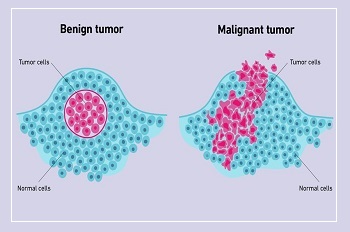
A tumor is a collection of cells that form an abnormal mass of tissue. Tumors can damage the bones, the skin, the tissue, the organs, and the glands. It is a common misconception that all tumors are cancerous, but this is not true. However, they may still require therapy.
There can be two types of tumors :
1.Benign tumors (Non-Cancerous Tumors) that are not life-threatening.
2.Malignant Tumors (Cancerous Tumors) cause cancer and are life-threatening.
Benign tumors can be painful and potentially dangerous, but they are less threatening than malignant tumors. Benign tumors generally do not invade or spread, whereas malignant cells are more likely to metastasize or migrate to other areas of the body.
Benign Tumor:
Benign tumors are not cancerous and are rarely fatal. They can grow to a large size and cause symptoms or discomfort, but they are not considered cancerous because they do not invade nearby tissues or spread to other parts of the body. While these conditions may cause discomfort or other symptoms, they are generally not life-threatening and can often be treated with simple procedures or medications.
Many benign tumors do not require treatment. However, certain noncancerous or benign tumors impinge on other bodily organs and require medical attention.
Some common examples of benign conditions include moles, cysts, and fibroids.
Possibility of the benign tumor becoming cancerous:
Some benign tumors can also become cancerous if abnormal cells continue to divide uncontrollably. These types of tumors are closely monitored.
Common types of benign tumors include:
1.
Adenomas
2. Fibromas
3. Desmoid tumors
4. Hamartomas
5. Hemangiomas
6. Lipomas
7. Leiomyomas
8. Myomas
9. Papillomas
Risk factors for benign tumors include:
* stress
* diet
* family history of tumors
* frequent infections
Treatment (If needed) :
In general, benign tumors grow slowly and some do not require treatment. Compressing nearby organs, nerves, and blood vessels, or growing in the brain or spinal cord, can pose serious health risks. These types of tumors usually need to be surgically removed. Once removed, most benign tumors don't grow back.
Malignant Tumor:
Malignant tumors are cancerous and have the potential to spread to other parts of the body. Malignant or cancerous tumors can spread into nearby tissue, glands, and other parts of the body. These tumors can be life-threatening.
Common malignant tumor types include:
* Carcinomas:
* Sarcomas
* Germ cells
* Blastomas
Risk factors for malignant tumors include:
* smoking
* alcohol use
* family history of cancer
* the type of tumor
* exposure to carcinogens
* genetics
* human papillomavirus (HPV)
* having obesity
* being overweight
Treatment:
Malignant conditions grow fast, so it can be very serious and require prompt treatment, such as surgery, radiation therapy, or chemotherapy. Cancerous tumors can come back after treatment.
Tuberculosis:
Tuberculosis, or TB, is a bacterial infection that primarily affects the lungs but can also affect other parts of the body. Tuberculosis (TB) and cancer are two distinct medical conditions that affect the human body in different ways. However, there may be some confusion or overlap between the two conditions in certain situations.
The confusion between tuberculosis and tumors or Cancer may come from the fact that TB can cause the formation of nodules, or small lumps, in the lungs. These nodules are called granulomas that may look similar to cancerous tumors on imaging tests, such as X-rays or CT scans.
However, granulomas are not tumors because they do not result from the uncontrolled growth of cells.
Additionally, TB can cause scarring in the lungs, which can sometimes be mistaken for a tumor on an X-ray or CT scan. While tuberculosis is not a tumor.
However, a qualified healthcare professional can usually distinguish between TB and a tumor based on a variety of factors, including the patient's medical history, symptoms, and diagnostic tests.
TB is treatable with antibiotics, while cancer may require more complex treatments such as surgery, chemotherapy, or radiation therapy.
In summary, benign, malignant, and tuberculosis are all medical conditions that can have different impacts on the body. Benign conditions are not cancerous and do not spread to other parts of the body, while malignant conditions are cancerous and have the potential to spread. Tuberculosis is a bacterial infection that can be highly contagious and primarily affects the lungs.


